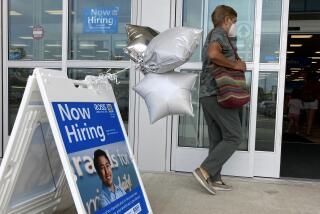Workers’ Output in 1990 Drops : Economy: The second decrease in productivity in a row was the sharpest since the last recession.
- Share via
WASHINGTON — American workers’ productivity in 1990 plunged at its sharpest rate since the last recession, marking the first time in a decade that productivity has fallen two years in a row, the government said today.
Meanwhile, the Labor Department’s report showed that during the final three months of 1990, the nation’s businesses trimmed the working hours of their employees at an annual rate of 2.7%--the largest falloff since the depths of the 1981-82 recession.
It was the second quarterly decline in the number of hours worked, which economists said can be expected during a recession, when businesses are implementing large-scale layoffs and making do with fewer employees.
Non-farm productivity--defined as output per hour of work--dropped 0.8% last year, the Labor Department said, the steepest decline since a 0.9% falloff in 1982.
Last year’s poor showing followed a 0.7% drop in 1989--the first time since 1979-80 that productivity declined for two consecutive years, the Labor Department said.
Increased productivity, or getting each worker to produce more during each hour of work, is considered vital to increasing the nation’s standard of living without inflation.
In the manufacturing sector, productivity declined at an annual rate of 2.4% in the October-December period--the largest drop since 1981. Meanwhile, factories trimmed their hours by 6.4% at the tail end of 1990.
The decline in manufacturing hours was the steepest since the final quarter of 1982, when hours fell 8.6%, the government said.
For all of 1990, manufacturing productivity increased 3% and hours worked fell 2.1%, the Labor Department said.
Meanwhile, hourly labor costs, a major measure of inflation for businesses, rose 3.8% in the fourth quarter. For workers, that translated into a 2.7% decline in compensation once consumer inflation was factored in, the government said.
Unit labor costs, a key gauge of future price inflation, rose 3.7% in the fourth quarter, compared to a 4.1% rise during the third quarter.
For all of 1990, hourly labor costs increased 3.5%.
More to Read
Inside the business of entertainment
The Wide Shot brings you news, analysis and insights on everything from streaming wars to production — and what it all means for the future.
You may occasionally receive promotional content from the Los Angeles Times.










